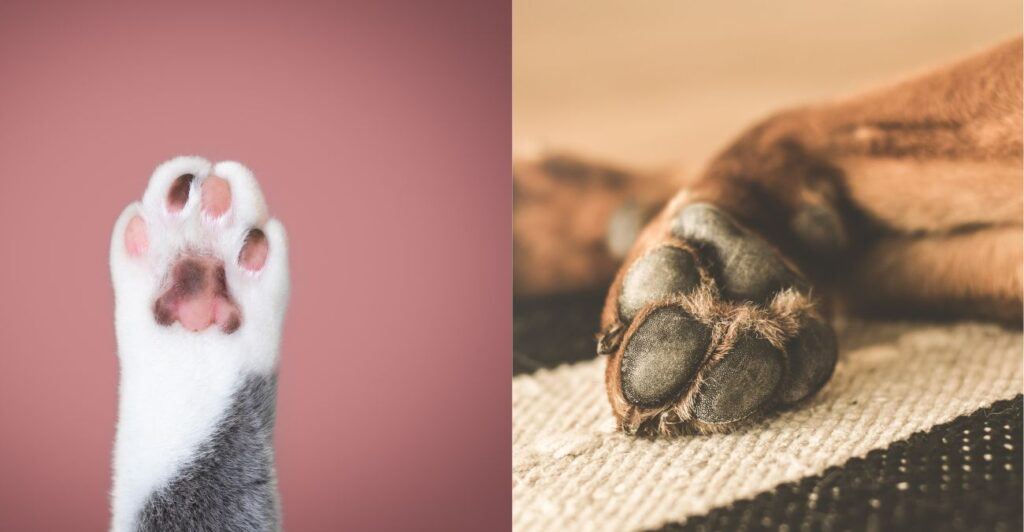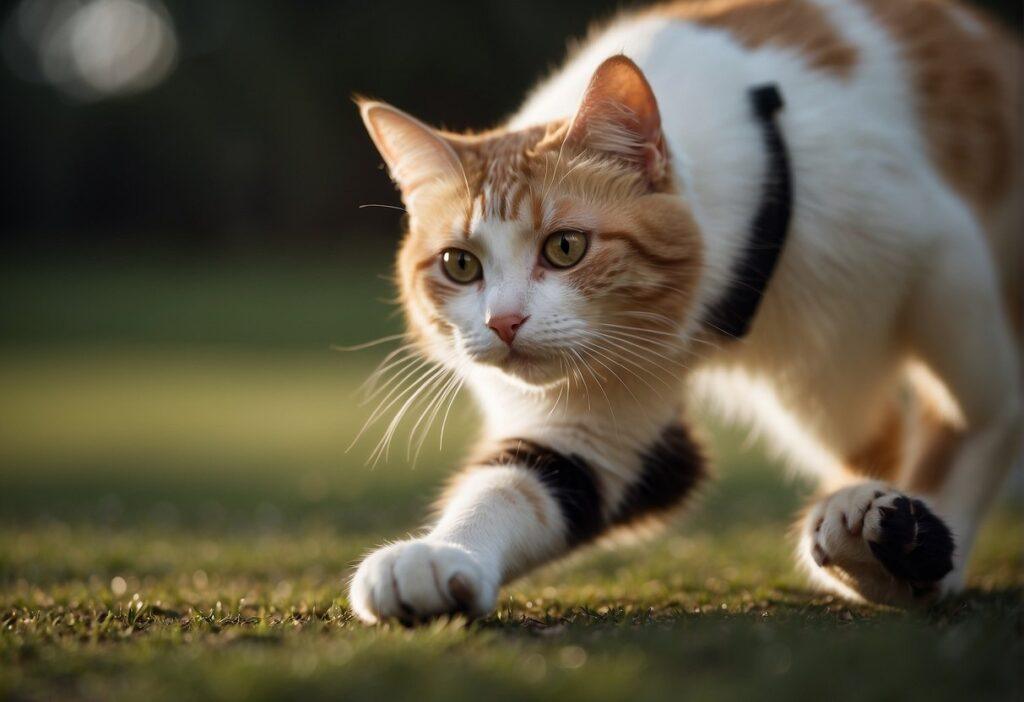Cat and dog paws may appear similar at a glance, but upon closer examination, several distinctive characteristics set them apart.
Both types of paws are perfectly adapted to the needs of the respective animals they belong to, with differences that extend beyond mere appearance.
For instance, the overall shape of the canine paw is generally more elongated than the typically rounder feline paw.
This reflects each animal’s evolutionary adaptations to their environments and lifestyles.
Cat Paw vs. Dog Paw

Critical differences between cat and dog paws include the presence of retractable claws in cats, which are absent in dogs.
This mechanism allows cats to keep their claws sharp for hunting and climbing. On the other hand, dogs have non-retractable claws that are more blunt and used for traction while running or walking.
Cats usually have softer, more cushioned paw pads compared to the rougher and tougher pads of dogs, a feature that enhances their stealthy movements.
Further distinctions can be noted in the structures and uses of their paws. Cats often use their paws to groom and manipulate small objects, necessitating fine motor skills and dexterity.
However, dogs typically use their paws to dig and support their weight while engaging in more vigorous activities.
These major differences between cat and dog paws have implications for pet care, such as the need for different types of nail care and protection from different environmental exposure.
Anatomy of Cat and Dog Paws
The anatomy of cat and dog paws is complex and specialized for their unique needs.
From the physical structure to the composition of paw pads and claws, these elements serve specific functions for each animal.
Physical Structure
Cats and dogs have differing physical structures in their paws that reflect their distinct lifestyles.
Cats possess highly agile front paws, essential for climbing and grasping. At the same time, their back paws provide stability during landing.
Each of the front feet of a cat has five toes, whereas the hind paws typically have four.
In contrast, dogs’ paws are built more for endurance. Their front paws bear more weight and are stronger than their rear paws, aiding acceleration and providing additional support.
A dog’s front and back paws usually have the same number of toes: four main toes and an extra claw known as the dewclaw.
Paw Pads
Both cats and dogs have paw pads that work as shock absorbers and provide traction. Cats have a large heel pad on each paw, which is actually the plantar pad, while each toe has its digital pads.
In comparison, dogs’ paws feature both metacarpal pads and digital pads, as well as a larger heel pad. These pads are generally tougher in dogs, as they are adapted for varying terrains.
- Cats: Front and rear paws have plantar pads and digital pads.
- Dogs: Possess metacarpal pads, digital pads, and a significant plantar pad on the rear paws.
Claws and Extra Claws
Cat claws are sharp, retractable, and used for hunting and climbing. The front paws have a set of retractable claws that can be extended for various activities.
This feature is absent in dog paws, whose non-retractable claws are more blunt and provide grip during movement.
Cats also have an extra claw on the front paws known as the ‘thumb’ or the ‘dewclaw,’ which aids in holding prey. Dogs may have a similar structure, but it is less functional.
While some dog breeds have dewclaws on their front feet, a few have them on the hind paws; however, they generally do not serve a significant purpose in most dogs.
Paw Print Identification

Paw print identification is key in distinguishing between species, such as domestic dogs and wild cats.
It involves careful observation of patterns and subtle differences that reveal insights into the animal responsible for the tracks.
Analyzing Patterns
When analyzing a paw print, one first looks at the overall shape and size. Cat paw prints typically show four toe pads and a smaller heel pad with no visible claw marks due to retractable claws.
In contrast, dog paw prints may often display claw marks and have a larger heel pad.
These pads’ shape and relative size give the most immediate clues to an animal’s identity. For clarity, some common traits are listed below:
- Feline paw: Rounded shape, no claw marks, retractable claws.
- Canine paws: Generally larger heel pad, visible claw marks, non-retractable claws.
| Animal Type | Toe Pads | Heel Pad | Claw Marks | Print Shape |
|---|---|---|---|---|
| Domestic Cat | 4 | Small | Absent | Rounded |
| Domestic Dog | 4 | Larger | Present | Triangular |
| Wild Cats | 4 | Small | Absent | Rounded |
| Wild Dogs | 4 | Larger | Present | Triangular |
One must consider the surrounding environment as it can affect the visibility of the paw print details.
Track Differentiation
One must consider the context and slight variances between paw preferences to differentiate between animal tracks, particularly those of domestic animals versus wild animals.
Domestic dog prints, or a puppy pet trace, tend to wander, indicative of a domestic setting where exploration is less targeted.
Tracks of wild animals, such as those of wild cats, often show a more direct path, suggesting a focused hunt or travel pattern.
The spacing between tracks and their depth can signal an animal’s size and weight, contributing to proper identification.
Field experts might use animal illustrations or reference guides to accurately compare cat paw prints to dog paw prints.
These resources often provide detailed drawings highlighting the distinctions between a cat’s and a dog’s paws. Below are some examples of what an expert might look for:
- Cat Track: Shorter stride, prints are close together, more rounded shape.
- Dog Track: Longer stride, prints are farther apart, overall larger print.
Remember, track conditions can influence these characteristics, and it’s essential to use a comprehensive approach integrating all available data to identify the animal accurately.
Paw Functionality and Movement

The section examines the intricacies of feline and canine paws in their movement across various terrains and the sensory capabilities they possess.
Terrain and Movement
Cats typically navigate rough surfaces and terrain with notable agility, their flexible paws allowing precision and balance.
In comparison, dogs may rely more on the strength and durability of their feet. Dogs are often observed powering over diverse terrains and maintaining stability at high speeds.
Statistics on movements such as acceleration or sharp turns may be represented in tabular form, differentiating how cats and dogs manage these actions:
| Aspect of Movement | Paws of Cats | Dog’s Feet |
|---|---|---|
| Navigating Rough Terrain | Highly flexible, soft pads | Sturdier, often larger pads |
| Running at High Speed | Sprinters, less endurance | Endurance, maintain speeds |
| Climbing | Expert climbers, retractable claws | Less vertical agility |
In the absence of claw marks, a paw footprint is likely that of a dog, as cats have retractable claws not typically seen in prints.
Sensory Perception
A cat’s paw is replete with nerves that make it highly sensitive, contributing to their remarkable sense of touch. This sensory perception allows for detecting vibrations, aiding in the hunt.
Dogs also have sensitive paws, with the added function of sweating through their footpads to regulate body temperature in hot or cold weather. The structural composition of their paws includes:
- Paws of Cats: Intensive nerve supply, retractable claws for gripping
- Dog’s Feet: Merocrine sweat glands, sturdy paw pads
While cats often use their acute sensory skills to hunt with stealth, dogs’ paw sensitivity contributes to their endurance and ability to traverse long distances, whether on a city sidewalk or in a rugged backcountry.
Behavioral Aspects and Preferences
Cats and dogs display distinct behaviors linked to their paws, which pet owners often observe.
Both animals use their paws to interact with their environment, with differences reflecting their respective personality traits and social habits.
Predatory and Social Behavior
Dogs have evolved as social hunters, which influences their paw behavior.
When engaging in predatory activities, dogs often use their paws to stabilize prey, assisted by their strong limbs and padded paws.
Socially, dogs are accustomed to living in packs. This is evident in their cooperation with their best friend, the human dog owner.
Dogs also have scent glands in their paws, and they might scratch the ground to mark territory and communicate.
Cats display a more solitary predatory style, precisely employing their paws to capture prey. Paw preferences play a role here, as some cats use one paw over another, similar to human handedness.
In a social context, cats are often more independent and may use their paws for personal grooming rather than social interaction.
Dogs and Cats Communication with Their Paws
Both cats and dogs use their paws to communicate, but they do so in various ways. Dogs commonly use their paws to initiate play or seek attention from their owners.
A gentle paw on the arm can mean a request for petting or playing. Search trends suggest that many dog owners are curious about interpreting their dog’s paw gestures.
| Dog Communication | Description |
|---|---|
| Pawing for Attention | Dogs often paw at their owners to show affection or request attention. |
| Play Initiation | A dog will use a paw to nudge another dog or human to signal the desire to play. |
Conversely, when cats extend their claws and knead, it’s often a sign of contentment and trust, a behavior that starts as kittens with their mothers.
They can use their paws to gently tap a human or another pet to garner attention or indicate a desire for interaction.
| Cat Communication | Description |
|---|---|
| Kneading | A sign of comfort and affection, often accompanied by purring. |
| Soft Taps | Cats may tap humans or other pets to initiate play or request something. |
Observing the paw use of cats and dogs can give insights into their mood and intentions. This provides valuable information for pet owners to strengthen their bond with their animal companions.
Related: Cat Paw Prints vs. Dog
Visual Characteristics of Paw Prints
When examining the visual characteristics of paw prints, one should pay attention to the unique shape and size attributes and the illustrative details that differentiate cat from dog paw prints.
Print Shape and Size
Cat paw prints typically present an oval shape, with four toe pads and a larger metacarpal pad, forming what may resemble a heart shape at first glance.
They are smaller, usually not exceeding 1-2 inches in diameter. In contrast, dog paw prints tend to be larger and rounder and may not form the neat heart shape seen in cat prints.
The print shape plays a critical role when distinguishing between these furry companions.
Upon closer inspection, dog prints reveal that the negative space between the toe pads and the metacarpal pad often aligns with an imaginary line drawn across the top of the toe pads.
This is typically not seen in cat prints. Size comparisons can be illustrated as follows:
- Cat paw prints: 1-2 inches in diameter (Oval)
- Dog paw prints: 2-3 inches or larger in diameter (Rounder)
Introducing Cory Haasnoot, a devoted father, loving husband, and enthusiastic cat lover. As a key content creator for CatFurLife.com, Cory blends his family values and passion for felines into engaging and informative content. He brings a unique perspective to the site, sharing cat care tips and how cats can enrich family life and bring joy to households.

